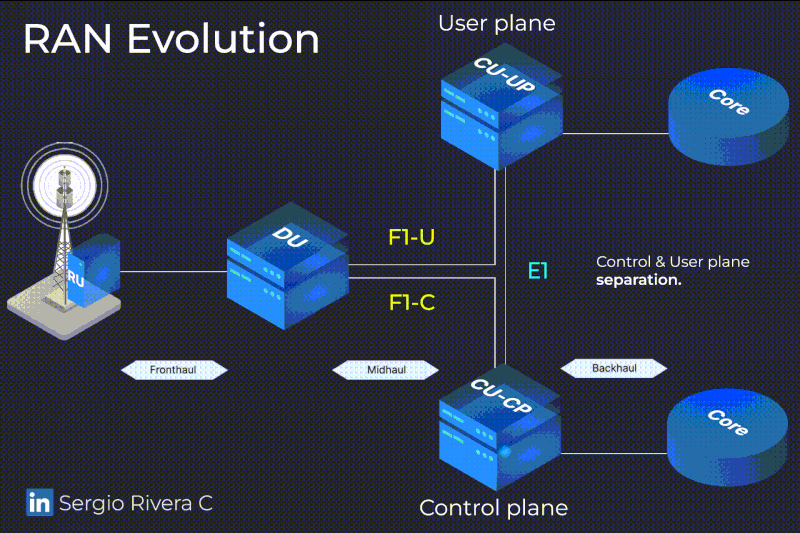5G introduces a new way of thinking about the Radio Access Network (RAN) compared to LTE. Instead of placing all protocol layers in a single “box,” 5G allows for a split architecture where different parts of the stack can be deployed in different locations, enabling more flexible and cost-effective networks.
𝗞𝗲𝘆 𝗖𝗼𝗻𝘀𝗶𝗱𝗲𝗿𝗮𝘁𝗶𝗼𝗻
A fundamental aspect of 5G RAN design is determining 𝗵𝗼𝘄 𝗺𝘂𝗰𝗵 𝗼𝗳 𝘁𝗵𝗲 𝗥𝗔𝗡 𝗽𝗿𝗼𝗰𝗲𝘀𝘀𝗶𝗻𝗴 𝗰𝗮𝗻 𝗯𝗲 𝘃𝗶𝗿𝘁𝘂𝗮𝗹𝗶𝘇𝗲𝗱 𝗶𝗻 𝘁𝗵𝗲 𝗰𝗹𝗼𝘂𝗱 𝗼𝗿 𝗶𝗻 𝗮 𝗱𝗮𝘁𝗮 𝗰𝗲𝗻𝘁𝗲𝗿, 𝗮𝗻𝗱 𝘄𝗵𝗶𝗰𝗵 𝗽𝗵𝘆𝘀𝗶𝗰𝗮𝗹 𝗲𝗹𝗲𝗺𝗲𝗻𝘁𝘀 𝗿𝗲𝗺𝗮𝗶𝗻 𝗮𝘁 𝘁𝗵𝗲 𝗰𝗲𝗹𝗹 𝘀𝗶𝘁𝗲.
𝗞𝗲𝘆 𝗖𝗼𝗻𝗰𝗲𝗽𝘁𝘀
![]() RAN Split:
RAN Split:
o The protocol stack (PHY, MAC, RLC, PDCP, RRC, NAS) can be divided into logical entities.
o These entities can be distributed across different physical units, not necessarily co-located with the antennas.
![]() DU (Distributed Unit):
DU (Distributed Unit):
o Handles lower-layer functions like PHY, MAC, and RLC.
o Deployed closer to the cell sites to manage real-time requirements.
![]() CU (Centralized Unit):
CU (Centralized Unit):
o Manages upper-layer functions such as PDCP and RRC.
o Can be placed in a centralized or cloud-based location.
o Can be further split into CU-CP (Control Plane) and CU-UP (User Plane) for greater flexibility.
𝗕𝗲𝗻𝗲𝗳𝗶𝘁𝘀 𝗼𝗳 𝘁𝗵𝗲 𝗦𝗽𝗹𝗶𝘁
![]() Scalability:
Scalability:
o Additional PHY/MAC capacity is handled by scaling the DU only.
o No need to invest in additional CU resources unnecessarily.
![]() Flexibility in Deployment:
Flexibility in Deployment:
o Different functions can run closer to the antenna, at the edge, or centralized in the cloud.
![]() Cost Efficiency:
Cost Efficiency:
o Avoids overprovisioning by enabling independent scaling of different layers.
𝗜𝗻𝘁𝗲𝗿𝗳𝗮𝗰𝗲𝘀 𝗗𝗲𝗳𝗶𝗻𝗲𝗱 𝗯𝘆 𝟯𝗚𝗣𝗣
![]() E1 → Between CU-CP and CU-UP
E1 → Between CU-CP and CU-UP
![]() F1-C → Between CU-CP and DU
F1-C → Between CU-CP and DU
![]() F1-U → Between CU-UP and DU
F1-U → Between CU-UP and DU
This architectural shift highlights how 5G RAN is designed to support diverse services such as eMBB, mIoT, and URLLC, with more efficient use of network resources.

![]() Related Content:
Related Content:
LinkedIn: ![]()